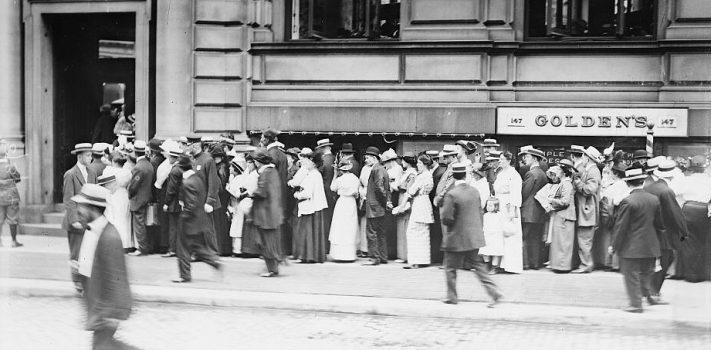Here are the latest news items and commentary on current economics news, market trends, stocks, investing opportunities, and the precious metals markets. In this column, JWR also covers hedges, derivatives, and various obscura. Most of these items are from JWR’s “tangibles heavy” contrarian perspective. Today, more about the developing global banking crisis.
Precious Metals:
We’ll start off today’s column with a video of excerpts from a presentation by Mike Maloney: “Change is Coming That Hasn’t Happened In 100 Years” – World Dumps US Dollar.
o o o
At Gold-Eagle.com: Gold price sees triple-digit gains in March, but can it set record highs in April?
Economy & Finance:
From The Economist: America risks propping up zombie banks.
o o o
‘Most U.S. banks are technically near insolvency, and hundreds are already fully insolvent,’ Roubini says. Here is a quote from Roubini’s insightful article:
“To be sure, rising inflation reduces the true value of banks’ liabilities (deposits) by increasing their “deposit franchise,” an asset that is not on their balance sheet. Since banks still pay near 0% on most of their deposits, even though overnight rates have risen to 4% or more, this asset’s value rises when interest rates are higher. Indeed, some estimates suggest that rising interest rates have increased U.S. banks’ total deposit-franchise value by about $1.75 trillion.
But this asset exists only if deposits remain with banks as rates rise, and we now know from Silicon Valley Bank and the experience of other U.S. regional banks that such stickiness is far from assured. If depositors flee, the deposit franchise evaporates, and the unrealized losses on securities become realized as banks sell them to meet withdrawal demands. Bankruptcy then becomes unavoidable.
Moreover, the “deposit-franchise” argument assumes that most depositors are dumb and will keep their money in accounts bearing near 0% interest when they could be earning 4% or more in totally safe money-market funds that invest in short-term Treasurys. But, again, we now know that depositors are not so complacent. The current, apparently persistent flight of uninsured — and even insured — deposits is probably being driven as much by depositors’ pursuit of higher returns as by their concerns about the safety of their deposits.
In short, after being a non-factor for the past 15 years — ever since policy and short-term interest rates fell to near-zero following the 2008 global financial crisis — the interest-rate sensitivity of deposits has returned to the fore. Banks assumed a highly foreseeable duration risk because they wanted to fatten their net-interest margins. They seized on the fact that while capital charges on government-bond and mortgage-backed securities were zero, the losses on such assets did not have to be marked to market. To add insult to injury, regulators did not even subject banks to stress tests to see how they would fare in a scenario of sharply rising interest rates.”
o o o
Social Security is now projected to be unable to pay full benefits a year earlier than expected.
o o o
o o o
WSJ: As Interest Rates Rose, Banks Did a Balance-Sheet Switcheroo. (Thanks to Peter for thelink.)
Commodities:
o o o
Banking turmoil will not be major hit to commodities finance – CFOs.
o o o
At OilPrice News: EV Slump Forces China’s Top Lithium Producers To Set Price Floor.
o o o
Prospective Plantings data gives grains a boost.
Inflation Watch:
Kiplinger’s Inflation Outlook: Inflation Eases a Bit, but Price Pressures Lurk.
o o o
UK Inflation and price indices: still spiking.
o o o
Pakistan posts highest-ever annual inflation; stampedes for food kill 16.
Forex & Cryptos:
Forex Market Forecast for April 2023.
o o o
At Currency Thoughts: March 2023 and First Quarter in Figures.
o o o
IMF: Currency units per SDR for April 2023.
Tangibles Investing:
The emerging banking crisis is likely to have some far-reaching consequences. On the plus side for tangibles, many investors are getting their money out of banks, and some of that money will be shifted into tangibles. But on the minus side, many bankers were accustomed to low interest rates for an unusually long period of time. They were forced to borrow money at high interest rates, while they still had many low interest rates loans on their books. So banks are under-capitalized just when they need cash the most. In the ensuing crisis, many tangibles may get dumped on the market. Be prepared for some turmoil in the tangibles markets, for several years. As always, do not buy tangibles with borrowed money. That is a recipe for disaster.
Provisos:
SurvivalBlog and its Editors are not paid investment counselors or advisers. Please see our Provisos page for our detailed disclaimers.
News Tips:
Please send your economics and investing news tips to JWR. (Either via e-mail or via our Contact form.) These are often especially relevant because they come from folks who closely watch specific markets. If you spot any news that would be of interest to SurvivalBlog readers, then please send it in. News items from local news outlets that are missed by the news wire services are especially appreciated. Thanks!










